case study
The Connecticut Transportation Safety Center Improves Road Incident Analysis with GIS
The ability to rapidly access accurate information on road incidents is enabled by GIS dashboards created by the Connecticut Transportation Safety Research Center. GIS technology is transforming road incident analysis in Connecticut, thanks to the innovative dashboards developed by the Connecticut Transportation Safety Research Center (CTSRC). Housed in the University of Connecticut's College of Engineering, the CTSRC's primary mission is to support the Connecticut Department of Transportation (CTDOT) in developing and maintaining a state-of-the-art crash collection and safety analysis system. As part of that mission, CTSRC has developed the Crash Repository for Analytics, Statistics, and History (CRASH). Through a series of geographic information system (GIS) dashboards, CRASH provides a comprehensive view of the crash, person, and vehicle data within the State of Connecticut. All the data available in the dashboards is refreshed daily to keep the information as current as possible.
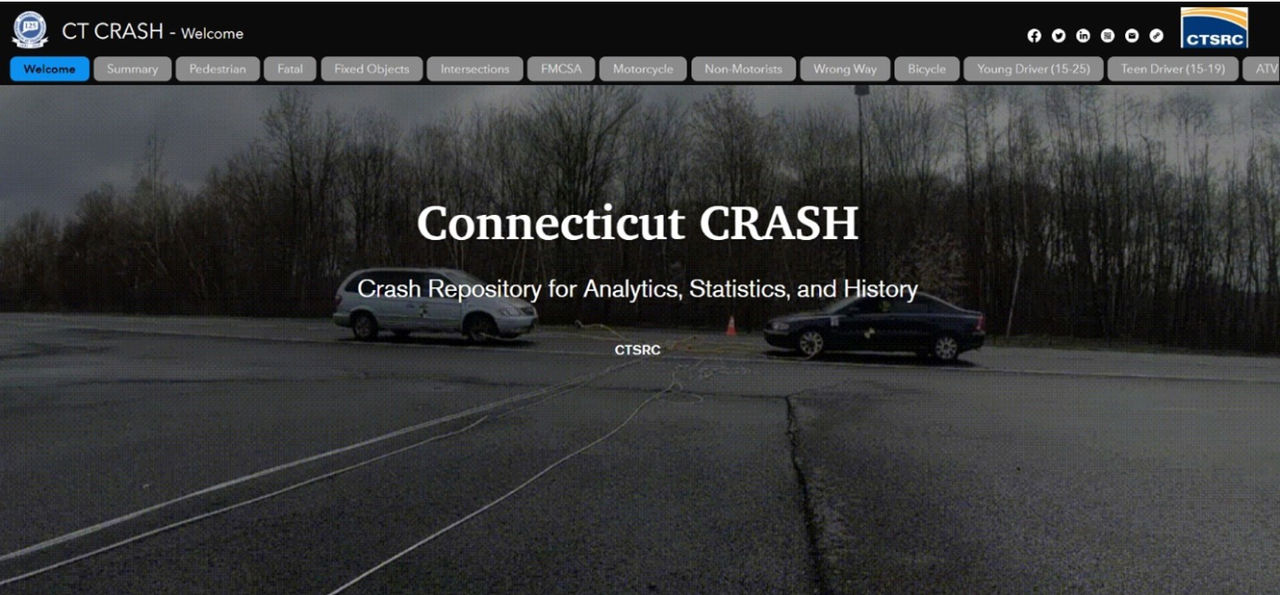 The Connecticut CRASH site provides a comprehensive view of crash, person, and vehicle data within the State of Connecticut.
The Connecticut CRASH site provides a comprehensive view of crash, person, and vehicle data within the State of Connecticut.
Crash Data Serves as Foundation for a Custom Tool
CTDOT’s journey started in 2011 with CTSRC’s utilization of crash data analytics as part of the Crash Data Repository. The database presently contains just under 2.7 million crashes that date back to 1995 and provides the underlying data for the CRASH application. An advantage that Connecticut has, according to Dr. Eric Jackson, executive director of the Connecticut Transportation Institute and director of CTSRC, is that all data gathered by the state is made publicly available. This makes the realization of a project such as CRASH a far simpler task than in other locations where engineers can struggle to access the same levels of information.
CTSRC brought on board two specialists of its own: Aaron Nash as the GIS project manager and Jennifer Pawelzik as the GIS database administrator. The team expanded to include several PhD students to help bring the vision of CRASH to life.
During the development of the tool, there were many permutations of trial and error within the application. “Several previous solutions were tried,” said Nash. “Performance of dynamic views was suboptimal, and prone to time-out errors. We tried creating the geometry of the crash location using Python and later changed it to build the geometry using SQL.” The methodology the team finally landed on is a stored SQL procedure scheduled to run nightly. This updates a series of feature classes that are published as dedicated feature services.
A first-phase solution provided crash-level location information and was designed simply to provide a GIS front end to complement the Crash Data Repository. However, this has since been significantly expanded in phase two, which added more person-level (age, gender, physical condition) and vehicle-level (make and model, age, levels of damage) data. In total, there are 26 "emphasis areas"–– data queries for each focus of the data providing insight on different types of crashes. The goal, according to Nash, is “to provide a full and comprehensive view of the MMUCC [model minimum uniform crash criteria] data in an easy-to-access format.” A separate service shows summary metrics that provide a high-level view of events.
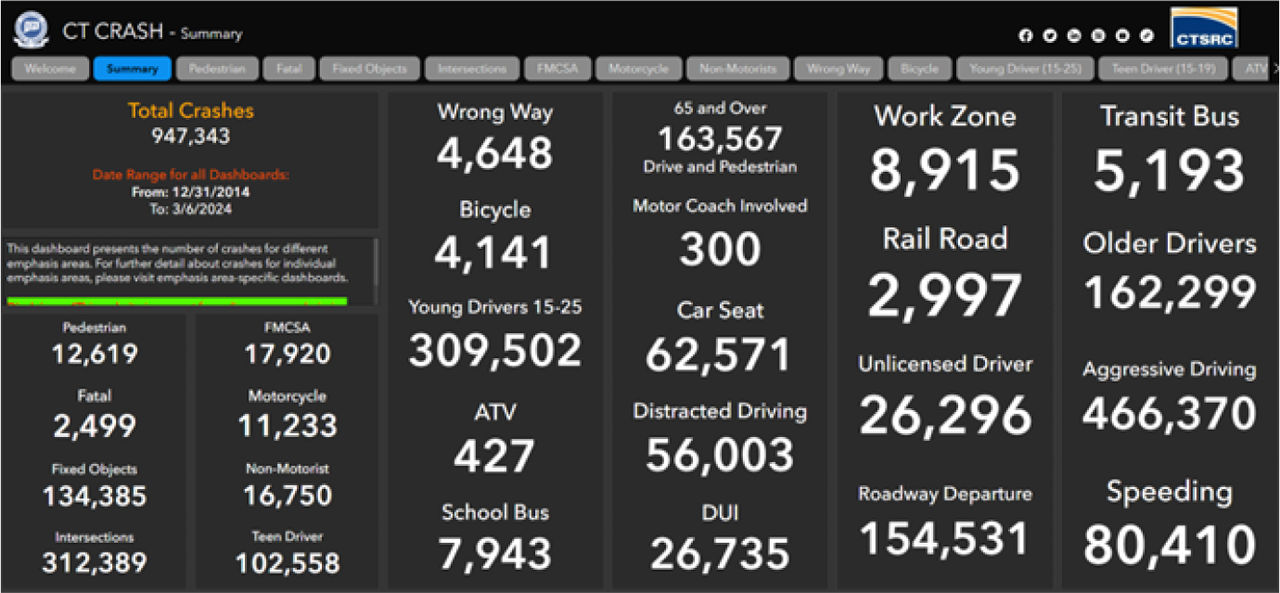 Summary metrics on the CRASH dashboard help decision-makers and agency staff understand patterns and priorities for improving transportation safety.
Summary metrics on the CRASH dashboard help decision-makers and agency staff understand patterns and priorities for improving transportation safety.
Easily Digestible Information
The pedestrian emphasis area illustrates how the data has been built up over time. In the crash-level view of the data, users can access locational and temporal details, in addition to information on circumstances contributing to an incident, such as the manner of collision, the roadway surface condition, and injury severity level. With the latest updates to the application, users can now view information specifically pertaining to the person- and vehicle-level view of the crash. For each of the 26 emphasis areas, there are dashboards that can be queried around the way the data is typically presented and analyzed by safety analysts.
Users access the information via a homepage designed to present it in an easily digestible format. A StoryMap was developed with background on the data and instructions on how to navigate the application to ensure that even those who are unfamiliar with GIS and crash data are still able to access the information they require.
The StoryMap is broken out into multiple sections describing the navigation of the dashboards, emphasis area definitions, rest service access, and information on the Crash Data Repository. This was built out based on a combination of frequently asked questions and the need to show the underlying metadata used for CRASH. The goal of the CRASH application is to provide front-end users with convenient access to commonly requested data queries that can be further drilled down using the filter options. For example, if a user wants the data for all fatal and serious injury crashes involving a nonmotorist in their town, they can navigate to the person-level nonmotorist dashboard and set the filters accordingly.
The team developed the dashboards using both Esri’s ArcGIS Experience Builder and ArcGIS Dashboards applications. The CRASH team’s migration to ArcGIS Enterprise 11.2 has also brought additional functionalities, such as the ability for users to download data, a mobile dashboard view, and a reset option.
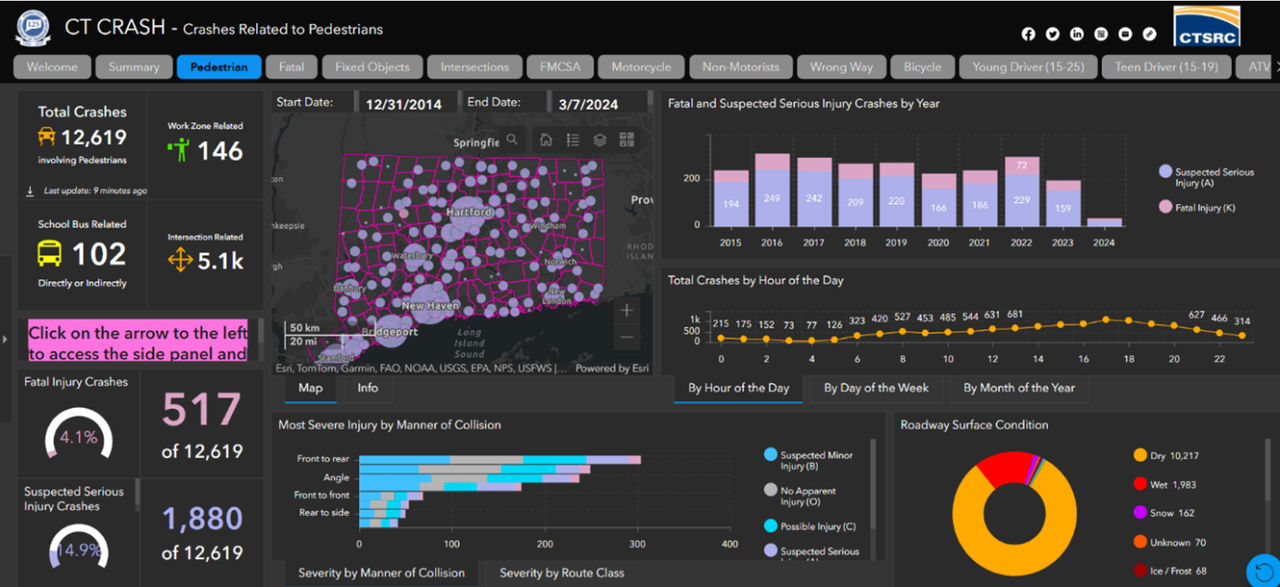 The Pedestrian dashboard showcases crash data involving pedestrians
The Pedestrian dashboard showcases crash data involving pedestrians
Adding and Verifying Data
CTSRC now has a standardized crash data workflow that pulls data from an SFTP site nightly, which enables daily updates. To ensure data accuracy, a team of crash coders scrutinizes each crash reported for location checks and general report errors. Esri tools are used to geolocate incidents and cross-reference the locations from reporting officers based off fields within the crash report and the crash diagram. The review process can take between 30 and 60 days for crashes involving property damage only. But fatal, injury, and commercial vehicle crashes automatically jump to the front of the queue and are processed within 24 hours of receipt. Once a crash has been reviewed by the coders and marked as completed, the information ends up in the Crash Data Repository, and ultimately the CRASH database.
With 110,000 crashes each year and a database that reaches back to 1995, CTSRC is now looking into how machine learning and artificial intelligence could be applied. This could include natural language processing of both the data itself for easier processing, but also leveraging AI to glean more information and insights from the intersection diagrams that accompany the crash reports.
Jackson notes that Connecticut’s dataset is a unique asset, and one that is ripe for the application of machine learning and AI, as well as more advanced analytics. To that end, the center has a number of graduate students, postdoctoral researchers, and safety engineers focused on leveraging the data to help drive safety research in the state.
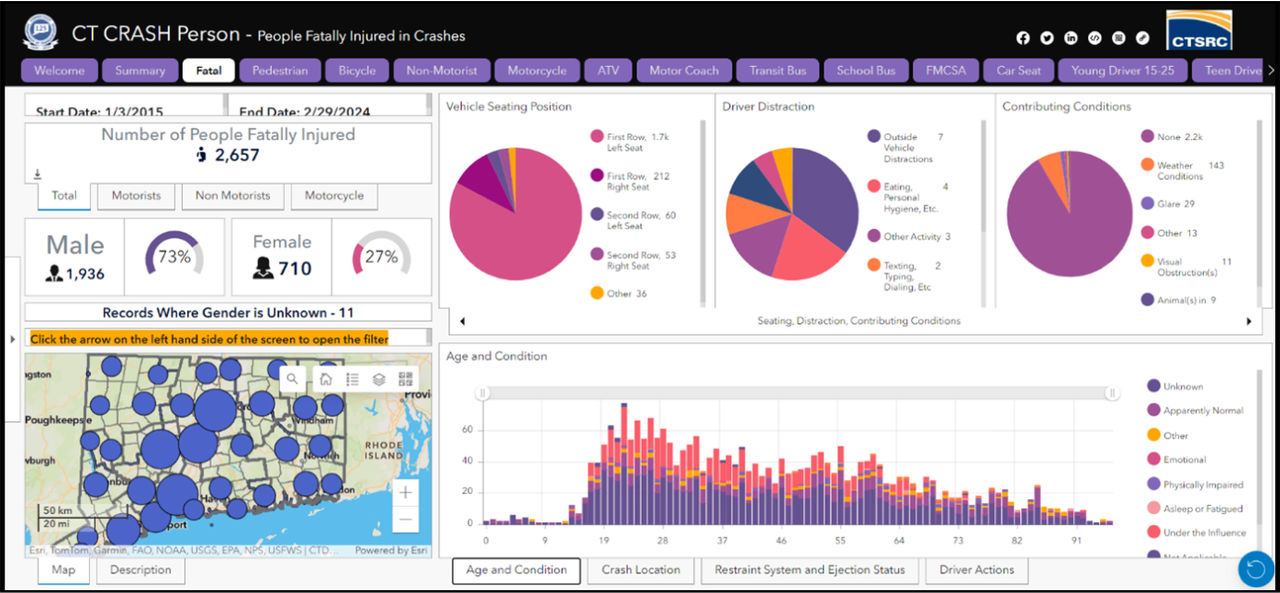 The Fatal Crash dashboard summarizes traffic fatalities across the state and allows CTDOT staff to understand where to focus resources to improve road safety.
The Fatal Crash dashboard summarizes traffic fatalities across the state and allows CTDOT staff to understand where to focus resources to improve road safety.
Improved Service for Residents
CTSRC’s contribution to CTDOT is illustrated by its support of local jurisdictions’ applications for grant funding from Safe Streets and Roads for All, a US Department of Transportation program. “We’ve had a lot of requests for help with identifying which intersections are the most dangerous for pedestrians and cyclists,” says Jackson. “We’re starting to see impacts in terms of needing to demonstrate where our problems are, so that we can start finding countermeasures and solutions, and we’re right on the cusp of understanding how towns are going to start using this data to help improve their chances of getting funding.”
The Connecticut Roadway Safety Management System and safety analysis tools, developed together with engineering consulting firm VHB, aim to improve those statistical methods and metrics. A next step for Jackson and his team is to organize a series of webinars that will help planning agencies better understand how to use these tools.
Having the crash data available in Esri’s ArcGIS Enterprise allows for the CRASH team to leverage the crash data and build out derivative datasets and applications to address needs within the state. An example of this is the CT-REDV, a red-light violation application that provides information for signalized intersections throughout the state. Grant support is available for red light camera installations at intersections, but local jurisdictions need to supply data for why they have selected specific locations.
Pawelzik took data from a time subset—January 2020 to December 2022—to build CT-REDV. A challenge arose in terms of standardizing the intersecting road names within the data, she says, because various combinations of road and route names could be used on the crash report form depending on where precisely within an intersection a crash occurred.
Now, instead of having to comb through crash data, towns can see the data they need in a more digestible format. They can identify the individual intersections that have sustained red light crashes and prioritize those intersections for red-light camera installations. All of this data can be broken out and downloaded as needed, and Pawelzik says the app provides a good example of the kinds of emerging requests that CTDOT receives from towns that the CTSRC is able to help with.
CTSRC's collection and management of the crash data allows the safety engineers at CTDOT to concentrate their efforts on the development of more effective safety measures––without having to shoulder the considerable burden of cleaning, geocoding, and validating the raw data, and the effort of managing a crash database with close to three million records.
As a result, responses to the solutions provided by CTSRC have been very positive, especially among the towns that have long-standing relationships with CTDOT and have been making regular data requests. In particular, the migration to Enterprise 11.2 has proven successful, enabling staff to download easily digestible information. And, although some of the data provided is highly granular, the presentation in GIS is proving useful to jurisdictions, helping them not only better understand and improve their safety performance, but also to be more strategic when looking to make infrastructure improvements.
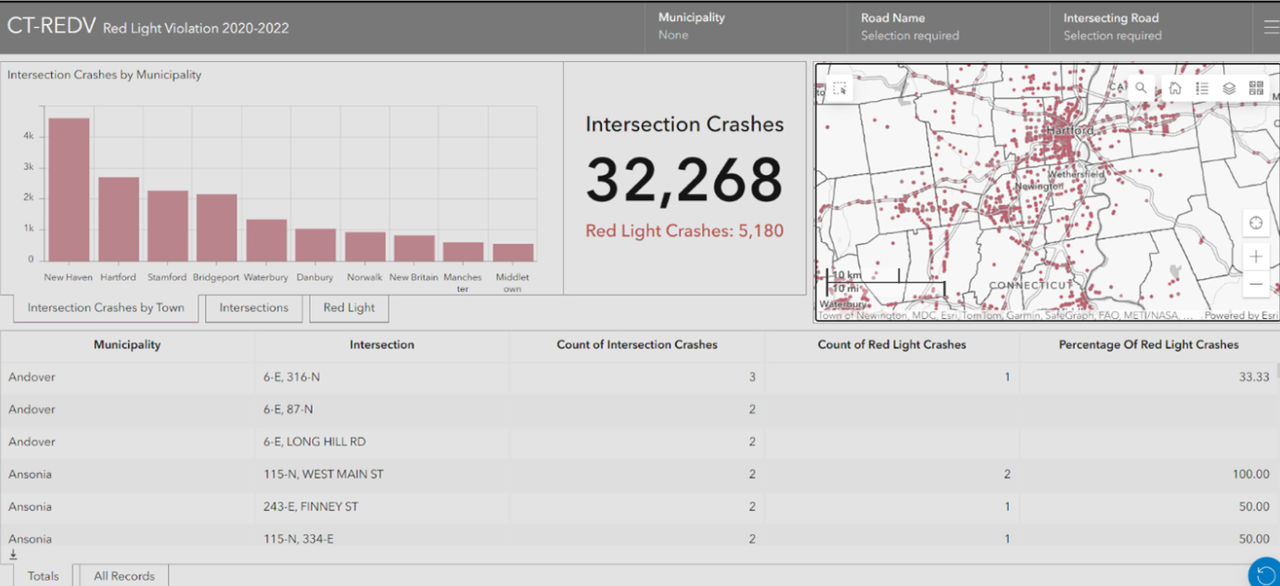 The Red Light Violation dashboard visualizes intersection crashes and shows CTDOT staff whether they should intervene to improve intersection safety.
The Red Light Violation dashboard visualizes intersection crashes and shows CTDOT staff whether they should intervene to improve intersection safety.